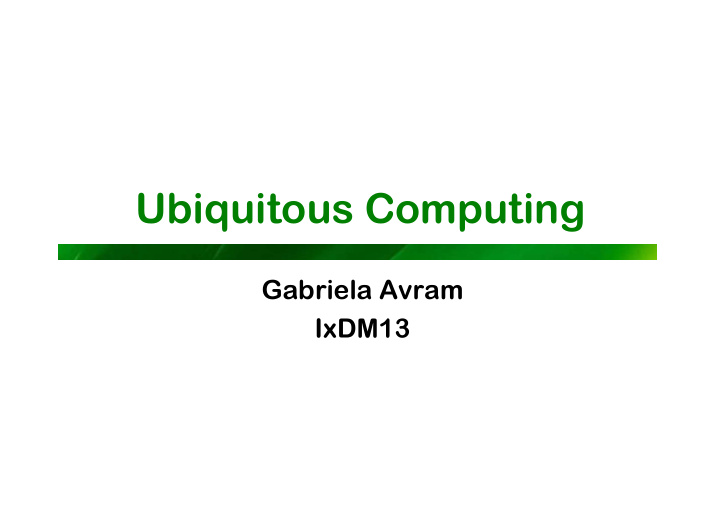



Ubiquitous Computing Gabriela Avram IxDM13
The Trends in Computing Technology 1970s 1990s Late 1990s Now and Tomorrow ?
Pervasive Computing Era
Computing Evolution
Ubiquitous Computing Mark Weiser, Xerox PARC 1988 “Ubiquitous computing enhances computer use by making many computers available throughout the physical environment, but making them effectively invisible to the user.” Source: Weiser, 1993a
Pervasive (Ubiquitous) Computing Vision “In the 21st century the technology revolution will move into the everyday, the small and the invisible…” “The most profound technologies are those that disappear. They weave themselves into the fabrics of everyday life until they are indistinguishable from it.” Mark Weiser (1952 –1999), XEROX PARC Small, cheap, mobile processors and sensors � in almost all everyday objects � on your body (“wearable computing”) � embedded in environment (“ambient intelligence”)
What is Ubiquitous Computing? Ubiquitous c biquitous com omputing puting (ubicomp) integrates computation into the environment, rather than having computers which are distinct objects. The idea of ubicomp enable people to interact with information-processing devices more naturally and casually , and in ways that suit whatever location or context they find themselves in.
Othe Other te r term rms use s used to de d to desc scribe ribe this pa this para radigm digm many of them are associated with a particular institution or perspective pervasive computing ambient intelligence everyware physical computing the "Internet of things" haptic computing things that think "spime"= theoretical object that can be tracked through space and time throughout the lifetime of the object (see Wikipedia explanation)
Goals of Pervasive (Ubiquitous) Computing Ultimate goal: Invisible technology Integration of virtual and physical worlds Throughout desks, rooms, buildings, and life Take the data out of environment, leaving behind just an enhanced ability to act
Pervasive Computing Phase I Phase I Smart, ubiquitous I/O devices: tabs, pads, and boards Hundreds of computers per person, but casual, low-intensity use Many, many “displays”: audio, visual, environmental Wireless networks Location-based, context-aware services Using a computer should be as refreshing as a walk in the woods
Smart Objects Real world objects are enriched with information processing capabilities Embedded processors in everyday objects small, cheap, lightweight Communication capability wired or wireless spontaneous networking and interaction Sensors and actuators
Smart Objects (cont.) Can remember pertinent events They have a memory Show context-sensitive behavior They may have sensors Location/situation/context awareness Are responsive/proactive Communicate with environment Networked with other smart objects
Smart Objects (cont.)
Generalized Moore’s Law Most important Problems: technology parameters • increasing cost double every 1–3 years: computation cycles • energy memory, magnetic disks bandwidth � Consequence: scaling down
Second Enabler: Communication Bandwidth of single fibers ~10 Gb/s 2002: ~20 Tb/s with wavelength multiplex Powerline coffee maker “automatically” connected to the Internet Wireless mobile phone: GSM, GPRS, 3G wireless LAN (> 10 Mb/s) PAN (Bluetooth), BAN
Body Area Networks Very low current (some nA), some kb/s through the human body Possible applications: Car recognize driver Pay when touching the door of a bus Phone configures itself when it is touched
Spontaneous Networking Objects in an open, distributed, dynamic world find each other and form a transitory community Devices recognize that they “belong together”
Third Enabler: New Materials Important: whole eras named after materials e.g., “Stone Age”, “Iron Age”, “Pottery Age”, etc. Recent: semiconductors, fibers information and communication technologies Organic semiconductors change the external appearance of computers “Plastic” laser Flexible displays,…
Interactive Map Foldable and rollable You are here!
Smart Clothing Conductive textiles and inks print electrically active patterns directly onto fabrics Sensors based on fabric e.g., monitor pulse, blood pressure, body temperature Invisible collar microphones Kidswear game console on the sleeve? integrated GPS-driven locators? integrated small cameras (to keep the parents calm)?
Smart Glasses By 2009, computers will disappear. Visual information will be written directly onto our retinas by devices in our eyeglasses and contact lenses -- Raymond Kurzweil
Fourth Enabler: Sensors/Actuators Miniaturized cameras, microphones,... Fingerprint sensor Radio sensors RFID Infrared Location sensors e.g., GPS ...
Example: Radio Sensors No external power supply energy from the actuation process piezoelectric and pyroelectric materials transform changes in pressure or temperature into energy RF signal is transmitted via an antenna (20 m distance) Applications: temperature surveillance, remote control (e.g., wireless light switch),...
RFIDs (“Smart Labels”) Identify objects from distance small IC with RF-transponder Wireless energy supply ~1m magnetic field (induction) ROM or EEPROM (writeable) ~100 Byte Cost ~$0.1 ... $1 consumable and disposable Flexible tags laminated with paper
UbiC biCom omp- whe p- where re a are re we we now? now?! ! Wha What doe t does it c s it cha hange nge? Wha What a t are re the the proble problems ye s yet to t to be solve be solved? d? space digital is material new layer of info people's needs and desires being here and there are balanced between hybridization - physical&digital utilitarianism and playfulness interaction production and use of traces of interaction Privacy -How can I trust the others Reliability / Availability – Always on network Social Impact - our lifestyle
Past the Ubicomp era? “ubicomp is no longer a niche research topic, but is best seen as the intellectual domain of all of computing.” (Abowd, 2012) To be continued…
Recommend
More recommend